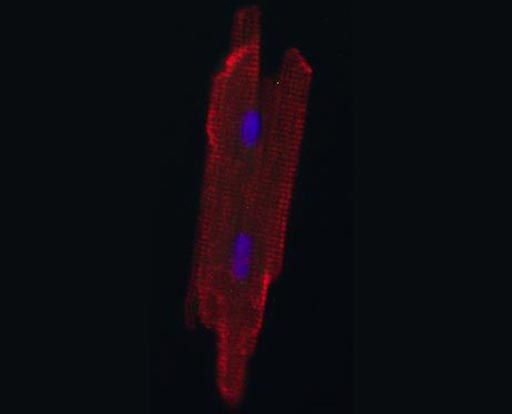Mature Heart Muscle Cells Created from Implanted Stem Cells
By LabMedica International staff writers
Posted on 10 Feb 2017
Bypassing a longstanding tissue culture challenge, researchers have succeeded in generating mature and viable human heart muscle cells in the laboratory by implanting, into newborn rat hearts, induced pluripotent stem cells (I-PSCs) from a healthy adult or an adult with a type of heart disease. The host rat heart provides the signals and chemistry needed by the implanted human immature heart muscle cells to progress and overcome the developmental block that has otherwise prevented their maturation in lab cultures.Posted on 10 Feb 2017
The researchers, from Johns Hopkins University School of Medicine, said their method should help advance studies of how heart disease develops, along with development of new diagnostic tools and treatments. "Our concept of using a live animal host to enable maturation of cardiomyocytes can be expanded to other areas of stem cell research and really opens up a new avenue to getting stem cells to mature," said study leader Chulan Kwon, PhD, associate professor at JHU School of Medicine.

Image: An adult heart muscle cell, grown in a newborn rat heart (Photo courtesy of Chulan Kwon, Johns Hopkins University School of Medicine).
According to Prof. Kwon, cell biologists have historically been unable to induce heart muscle cells to develop past the point characteristic of newborns, even when they let them mature in tissue culture for a year. Those neonatal heart cells are smaller and rounder than mature adult heart cells and generate very low pumping force. As a result they do not serve as a good model for heart muscle diseases, they do not mimic well the biology and chemistry of adult heart tissue.
Prof. Kwon's group recently showed that the tissue cultured cells were not turning on the proper genes required to allow for the transition to maturity. But they also found that the required genes were similar to those activated in newborn rat hearts.
In their initial experiments designed to overcome the developmental block, the researchers first created a mouse cell line of immature heart cells taken from mouse embryonic stem cells. They tagged these cells with a fluorescent protein and injected about 200,000 of the cells into the ventricle of newborn nude rats (rats with deficient immune systems that would not attack and reject the newly introduced cells). After about a week, the fluorescent cells were still rounded and immature-looking. After a month, however, the cells resembled adult heart muscle cells – elongated with striped patterns. Using a type of optical microscopy, the investigators confirmed that the new heart-grown cells could contract (beat) like normal adult heart muscle cells.
By comparing 312 genes in the individual mouse cells grown in the rat hearts to the genes found in both immature heart cells and adult heart muscle cells, they found that the cells grown in the rat hearts had more in common with genetics of adult than of immature heart muscle cells.
Next, in a set of proof-of-concept experiments, the team worked with human adult skin cells, from a healthy human donor, that were then chemically converted into induced pluripotent stem cells (I-PSCs). A month after these cells were implanted into newborn rat hearts, the healthy human donor cells appeared rod-shaped and mature.
In the final proof-of-concept experiment, the researchers used I-PSCs taken from a patient with arrhythmogenic right ventricular cardiomyopathy (ARVC), an inherited form of heart disease and a leading cause of sudden death in young adults. These cells were of special interest because the genetic mutation that causes AVRC leads to symptoms only after the heart cells mature. After a month growing the human ARVC immature heart cells in the rat heart ventricles, the cells began to demonstrate properties of heart tissue from patients with the disease. Specifically, they accumulated fat and more of the cells were dying than in healthy heart tissue.
This last experiment, Prof. Kwon said, shows that researchers can now consistently grow mature cardiomyocytes from patients with specific heart diseases to better study these diseases and help identify targeted treatments. He cautions that clinical use of these lab-grown cells is years away, but "the hope is that our work advances precision medicine by giving us the ability to make adult cardiomyocytes from any patient's own stem cells." Having that capability, he added, would mean having a way to test each patient for potential drug sensitivities and effectiveness, and having a scalable process to create large sources of cells for heart regeneration."
The study, by Cho GS et al, was published online January 10, 2017, in the journal Cell Reports.













